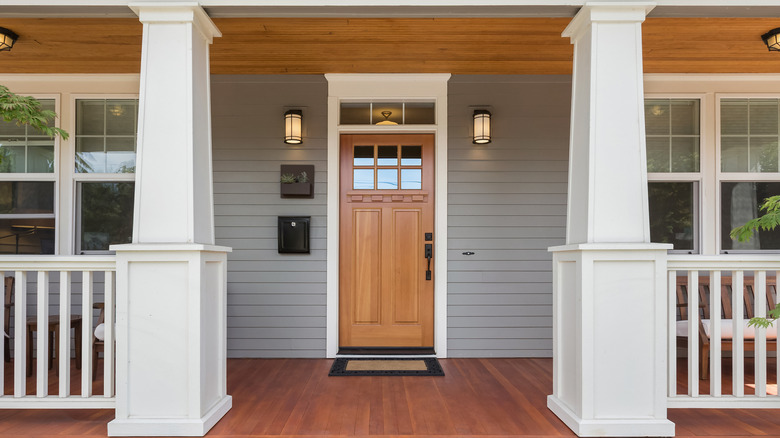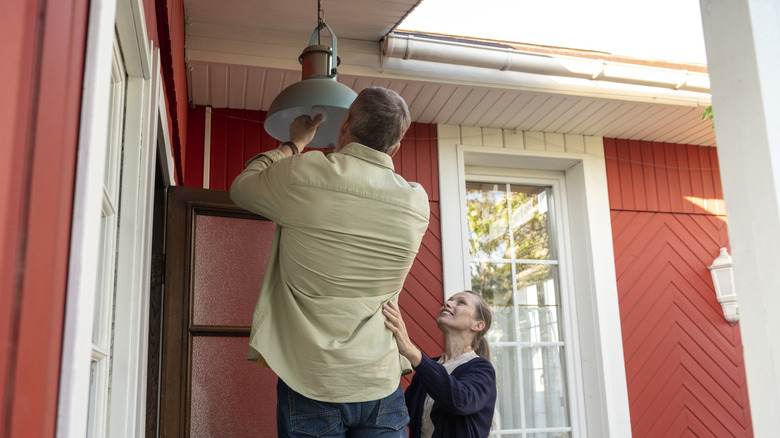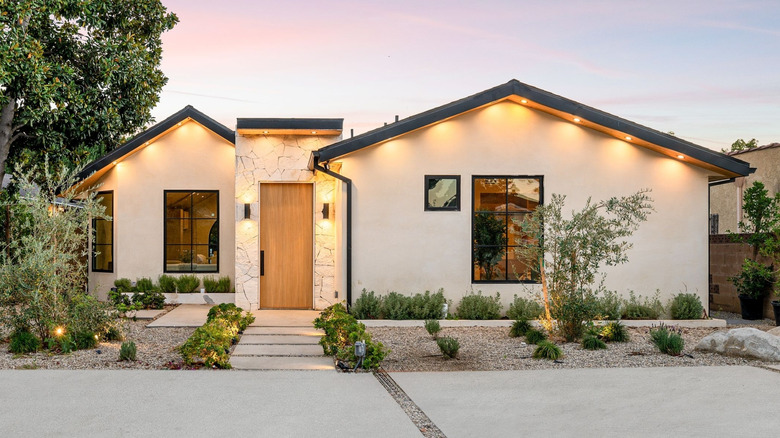How To Choose And Place The Right Size Outdoor Light
We may receive a commission on purchases made from links.
While outdoor lights are certainly useful for illuminating exterior walkways and door entrances, they can also go a long way towards increasing your home's curb appeal — if they are sized and placed appropriately, that is. On the other hand, if your exterior lighting does not coordinate well with the scale or style of your home, it can have quite the opposite effect. With such a wide array of outdoor lighting choices available, it can be overwhelming to narrow down which ones will work best for your home. Luckily, there are a few tried-and-true tenets you can stick to, like choosing fixtures proportionate to your exterior door, that will help you select the proper size for all your outdoor lights and install them at the perfect height to maximize your home's design.
Whether you have a tiny bungalow-style home or a sprawling two-story Mediterranean-inspired villa, the right light size and placement all boils down to the same basic principles — the fixture being the proper ratio to your home's existing features and being installed at the proper height so the light is both functional and aesthetically pleasing. As a bonus, you should make sure that all of your exterior lights coordinate well with each other. Now that you have the basics under your belt, it's time put all of these principles into practice.
The best exterior light size and placement
Choosing lights that are too small and hanging them too high or low are common mistakes that can damage your home's curb appeal. The best reference point to determine the proper light size is the height of your front door. Ideally, sconces should be at least 1/4 to 1/3 the height of your doorway, and hanging pendant lights should be 1/5 the size. As for placement, you want the sconces center-mounted slightly above eye level (66 to 72 inches from the floor) and spaced 6 inches from the door. Whereas pendant lights should be centered above the frame with at least 6 inches between the bottom of the light and the top of the door.
The same 1/4 to 1/3 ratios apply for lights on your patio or deck. For garages, follow the same sizing rule, except use the height of the garage door as your reference point. Garage lights can be placed above the garage door(s) or on the sides, above eye level. If you have a two-door carport, you can also place a third light between them.
Finally, lamp posts should be 6 feet high with a light topper that's at least 1/3 of its height. These are best placed at the beginning of a walkway or the end of a driveway. Accent path lights can be 14 inches tall and spaced a few feet from each other, as well as 6 inches away from the trail. You can also stagger them on both sides of the path for a more elevated look.
Choose a lighting style that complements your home
In addition to improving front door security, outdoor lights can also enhance your home's exterior style. Instead of strolling down the lighting aisle at your local hardware store and picking out the first thing that catches your eye, it's best to choose a fixture that works well with the style of your home. While you may love the design of nautical sconces, they'd likely look out of place installed on a Victorian house. Take time to research your home's architectural style and which lighting aesthetic works best. For example, lantern lights, like this Lamomo Outdoor Wall Light, work well with Cape Cod-style houses. Classic fixtures, like this MATAMEYE Outdoor Wall Lantern, pair well with Federal-style homes.
It's also wise to select a color and finish (brass, matte black, etc.) that complements your home's exterior design. Consider the shade of your front door, shutters, and siding. Also think about the finish on your hardware. If your home is mostly cool-toned, such as blue or gray siding with white trim, lights with a nickel finish would be a great option. Brass or oil-rubbed bronze, on the other hand, would look lovely on a home with warm tones, such as red brick. Stick to similar lighting styles among your home's entry, garage, and landscape as well. They don't have to match exactly, but it's best to select lights with similar silhouettes or finishes to lend a cohesive look to your home's exterior.


